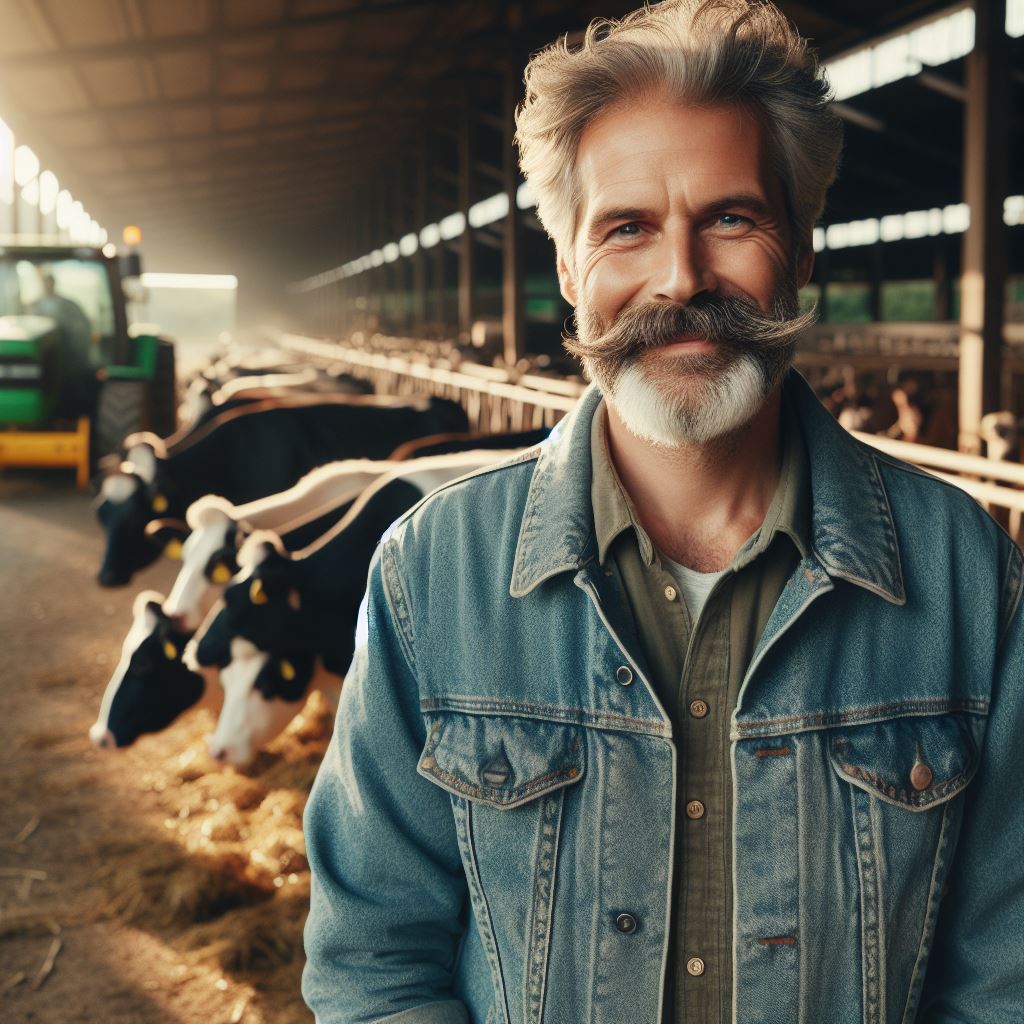Introduction
As we explore “Organic Dairy Farm Journey” we prioritize the well-being of animals and the stewardship of natural resources.
In recent years, there has been a significant shift towards organic farming practices in agriculture.
This shift involves moving away from conventional methods of farming that heavily rely on synthetic fertilizers, pesticides, and genetically modified organisms (GMOs).
Organic farming emphasizes the use of natural and sustainable techniques to cultivate crops and raise livestock.
One sector of agriculture that has witnessed this organic shift is dairy farming. Traditionally, dairy farming has been associated with large-scale operations that prioritize productivity and profitability.
However, the environmental and health consequences of such practices have become increasingly evident.
Conventional dairy farming often involves the use of synthetic growth hormones to increase milk production, as well as the excessive use of antibiotics to prevent diseases in livestock.
Additionally, the reliance on chemical fertilizers for growing animal feed crops contributes to soil degradation and water pollution.
Furthermore, the overuse of chemical pesticides in crop production can contaminate water sources and affect the overall ecological balance.
These practices not only harm the environment but also pose potential risks to human health through the consumption of contaminated dairy products.
As the demand for sustainable and healthier food options grows, more dairy farms are making the transition to organic methods.
This includes providing cows with access to pasture, avoiding the use of synthetic hormones and antibiotics, and employing natural methods to manage pests and diseases.
The organic shift in dairy farming not only benefits the environment but also produces milk and dairy products that are free from harmful residues.
Consumers are increasingly choosing organic dairy products, recognizing their superior quality and the positive impact they have on their health and the environment.
In the following sections, we will delve into the journey of a dairy farm that embraced the organic shift, highlighting the challenges faced, the benefits reaped, and the lessons learned along the way.
Transform Your Agribusiness
Unlock your farm's potential with expert advice tailored to your needs. Get actionable steps that drive real results.
Get StartedStay tuned for an inspiring tale of sustainability and responsibility in the world of dairy farming.
Pre-Organic Era
Traditional dairy farming practices
In the Pre-Organic Era, dairy farming relied on traditional methods, lacking the sustainability focus we see today. Synthetic fertilizers and pesticides dominated, impacting both the environment and product quality.
Health concerns associated with conventional dairy products
However, with concerns about the negative impact on both the environment and human health, a shift in mindset began to occur.
Consumers started to realize the potential health risks associated with consuming conventional dairy products.
Growing demand for organic products
- The growing demand for organic products, including dairy, spurred change in response to consumer concerns about harmful chemicals.
- Conventional dairy adapted to meet these concerns, pushing farmers to explore sustainable, organic principles.
- Transitioning involved reevaluating farming methods, from eliminating synthetic fertilizers to focusing on humane animal welfare.
- Challenges included finding alternatives for pest control, ensuring natural cow environments, and changing feeding regimens for health.
- Organic dairy requires sustainable waste management, utilizing manure, and complying with strict organic certification regulations.
- Despite the financial investment, farmers saw long-term benefits in increased consumer demand and premium prices for organic products.
Overall, the pre-organic era was marked by traditional dairy farming practices that relied on synthetic inputs and faced growing consumer concerns.
The demand for organic products pushed farmers to embrace alternative farming methods that focused on sustainability, animal welfare, and consumer health.
Transitioning to organic farming required significant changes in farming practices and adherence to strict organic standards.
Despite the challenges, many farmers recognized the potential benefits and embarked on the transformative journey towards organic dairy farming.
Read: Trailblazing Women: Stories from the Farm Fields
The decision to Go Organic
Factors influencing the dairy farm’s decision to transition to organic
The dairy farm carefully considered several factors before deciding to transition to organic farming.
- One important factor was the increasing demand for organic dairy products in the market.
- The farm recognized the potential profitability of tapping into this growing market.
- By going organic, they saw an opportunity to attract more customers and increase their sales.
- Additionally, the dairy farm considered the environmental benefits of organic farming practices.
- They wanted to contribute to the preservation of the ecosystem and reduce their carbon footprint.
- Switching to organic would allow them to minimize the use of synthetic fertilizers and pesticides.
- They believed that taking care of the environment was not only responsible but also a long-term investment.
- The dairy farm recognized the importance of sustainable agriculture for future generations.
- They understood that organic farming promotes soil health and biodiversity, ensuring a more resilient ecosystem.
- Moreover, going organic would allow the dairy farm to improve the welfare of their cows.
- Organic standards include providing cows with access to pasture and avoiding the use of growth hormones.
- These practices align with the farm’s commitment to animal welfare and their values.
Market opportunities and potential profitability
- Before making the final decision, the dairy farm conducted market research.
- They analyzed consumer trends and preferences, which confirmed the market potential for organic dairy products.
- It became clear that going organic would not only benefit the farm financially but also meet consumer demands.
- Transitioning to organic farming required careful planning and preparation.
- The farm invested in training for their employees to ensure a smooth transition process.
- They also sought guidance from organic farming experts to maximize their chances of success.
Environmental benefits of organic farming
The dairy farm understood that the transition might come with initial challenges.
The environmental benefits aligned with the farm’s commitment to sustainability. Furthermore, organic farming allowed them to prioritize the welfare of their cows.
However, they were confident that the long-term benefits would outweigh any short-term difficulties.
In fact, the decision to go organic was driven by various factors. The market opportunities and potential profitability were promising.
With careful planning and preparation, the dairy farm embraced the organic shift confidently.
Read: Banker to Barn: Finance Minds in Farming
Transition Process
Steps taken by the dairy farm to become certified organic
Transitioning to become a certified organic dairy farm was not an easy task, but we were determined to make the shift. Here are the steps we took to achieve organic certification:
- We researched organic farming practices and regulations, identifying necessary steps for adjustment.
- Eliminating synthetics, we boosted soil organic matter with compost and cover crops.
- Rotational grazing and organic feed improved soil health and animal welfare.
- Investing in organic-approved pest control, we kept meticulous records for certification.
- We applied for certification, addressing inspection recommendations for compliance.
- After meeting requirements, we proudly display our organic certification on the farm.
Challenges faced during the transition
Transitioning to organic farming came with its fair share of challenges, but we overcame them through determination and perseverance:
- One of the major challenges was the financial aspect. Transitioning to organic farming required upfront investment in organic inputs and infrastructure.
- We faced resistance from some conventional farmers in our area who were skeptical about the benefits and viability of organic farming.
- Adapting to new methods and practices was another challenge. We had to learn and implement new techniques that were different from what we were used to.
- Dealing with pests and diseases without the use of conventional pesticides presented a learning curve, but we managed to find effective organic alternatives.
- Sometimes, finding a certified organic source for inputs like fertilizers or animal feed proved challenging, but we built reliable networks over time.
Compliance with organic farming regulations and standards
Compliance with organic farming regulations and standards was a top priority for us throughout the transition process:
- Strictly followed the guidelines set by the organic certification agency, ensuring all our practices aligned with their standards.
- We maintained detailed records of our farming practices, such as soil management, pest control, and animal health care.
- We regularly reviewed and updated our practices to stay current with any changes in organic regulations.
- We were transparent with our customers, displaying our organic certification and providing information about our farming practices.
- We welcomed third-party inspections to ensure we were consistently meeting the organic standards.
Transitioning to organic dairy farming was a challenging yet rewarding journey.
We are proud to be a certified organic farm, providing wholesome products while respecting the environment and the well-being of our animals.
Read: Fashion to Fertilizer: Stylish Farm Beginnings

Adoption of Organic Practices
Elimination of synthetic chemicals and hormones
Synthetic chemicals and hormones, once staples in conventional farming, had to be phased out to align with organic principles.
Farmers meticulously evaluated each aspect, ensuring no residue of harmful substances lingered in the soil or the produce.
Showcase Your Farming Business
Publish your professional farming services profile on our blog for a one-time fee of $200 and reach a dedicated audience of farmers and agribusiness owners.
Publish Your ProfileThe elimination process required finding alternative solutions for pest control, nutrient management, and disease prevention.
Transition to organic feed and forage
With synthetic chemicals out of the equation, the focus shifted to the very essence of farming – the feed.
Transitioning to organic feed and forage meant adopting sustainable practices that enriched the soil and enhanced the nutritional quality.
Cover crops and organic compost became allies in the quest for healthier soil, supporting robust plant growth and nutrient-rich feed.
Focus on animal welfare and pasture-based grazing
Animal welfare took center stage, redefining the living conditions for cows and challenging the confinement norms of conventional farming.
Pasture-based grazing became a cornerstone, offering cows not just a diet but an experience that mirrored their instincts.
Access to the outdoors, more space, and the absence of antibiotics and hormones became non-negotiable standards for the well-being of the animals.
Sustainable waste management techniques
Sustainable practices extended to waste management, where the once-disposed manure emerged as a valuable resource.
Utilizing manure as a natural fertilizer closed the loop, reducing dependence on synthetic alternatives and contributing to soil health.
Efficient systems were implemented to minimize waste, highlighting the commitment to environmental responsibility.
The journey from conventional to organic was a symphony of changes, each note resonating with the commitment to sustainable and ethical farming.
The adoption of organic practices wasn’t just a shift; it was a revolution, redefining the narrative of farming for a better tomorrow.
Benefits and Challenges of Organic Dairy Farming
Benefits
Improved soil health and reduced impact on water resources
Organic dairy farming practices focus on enhancing soil health through composting, crop rotation, and the use of natural fertilizers.
These practices help maintain soil fertility and reduce the risk of contamination in water resources.
Enhanced animal welfare leading to higher-quality milk
Organic dairy farms prioritize the well-being of their cows, providing them with access to pasture, fresh air, and a natural diet. This leads to healthier cows, higher milk quality, and lower instances of diseases.
Increased consumer demand for organic dairy products
- The increased consumer demand for organic dairy products presents a significant market opportunity.
- As more people become aware of the benefits of organic food, there is a growing preference for organic dairy products.
- This trend enables organic dairy farmers to expand their market reach and potentially increase their profits.
Challenges
Limited availability of organic feed sources
One of the challenges faced by organic dairy farmers is the limited availability and higher cost of organic feed sources.
It requires careful planning and sourcing to ensure a consistent supply of organic feed for the cows.
Market competition and price premiums
- Additionally, market competition poses a challenge for organic dairy farmers.
- As more players enter the organic dairy market, farmers need to differentiate their products to stand out.
- Justifying the price premiums associated with organic production becomes essential in attracting and retaining consumers.
- Organic dairy farmers must effectively communicate the value and benefits of their products to compete successfully in the market.
In short, organic dairy farming offers various benefits for both the environment and consumers.
The focus on improved soil health, animal welfare, and meeting the increasing demand for organic dairy products is essential.
Overcoming challenges like limited feed availability and market competition requires strategic planning and a commitment to delivering high-quality organic products.
Despite the challenges, the organic shift in dairy farming presents a promising future for sustainable agriculture.
Results and Impact
Positive outcomes experienced by the farm after transitioning to organic
- The farm noticed an increase in the overall health and well-being of their animals.
- Organic practices led to higher milk quality, resulting in increased demand and premium prices.
- Transitioning to organic farming boosted the farm’s reputation as a sustainable and ethical producer.
- The farm experienced improved soil health, leading to higher crop yields and reduced dependency on fertilizers.
- Organic practices also led to a reduction in the use of antibiotics and chemicals, promoting natural animal and plant health.
Reduction in greenhouse gas emissions and contribution to sustainability
The shift to organic farming had a significant impact on reducing greenhouse gas emissions:
- Elimination of synthetic fertilizers, pesticides, and herbicides reduced the farm’s carbon footprint.
- The use of organic fertilizers and crop rotation increased soil carbon sequestration, mitigating climate change.
- The decrease in reliance on machinery and fossil fuels further reduced emissions from the farm.
- Farm practices, such as composting and methane capture, contribute to waste management and minimize emissions.
- Overall, the farm’s transition to organic has made a positive contribution to environmental sustainability.
Influence on neighboring farms and the local community
The organic shift of the dairy farm has had a ripple effect on neighboring farms and the local community:
- Neighboring farms have shown interest in adopting organic practices after witnessing the farm’s success.
- The organic farm has become a local hub for knowledge sharing, hosting workshops, and guiding other farmers.
- The local community has embraced the farm’s commitment to sustainability and ethical farming.
- Increased collaboration between the farm and local businesses has created market opportunities for organic products.
- The farm’s positive impact on the community inspires other individuals to support organic agriculture.
In essence, the transition to organic farming has brought about numerous positive outcomes for the dairy farm.
Not only have they experienced improved animal health and higher milk quality, but they have also contributed to sustainability by reducing greenhouse gas emissions.
The farm’s organic practices have influenced neighboring farms and fostered a sense of community, promoting the adoption of organic farming methods.
The results and impact of this organic shift demonstrate the importance of sustainable and ethical practices in the agricultural industry.
Read: From Coding to Cultivating: IT to Farming
Conclusion
As we conclude this journey of the organic shift in dairy farming, it is evident that the significance of this transformation cannot be overstated.
The shift to organic practices has not only benefitted our farm but also raised the bar for the entire industry.
We strongly encourage other dairy farms to consider transitioning to organic methods. The environmental and health benefits are undeniable, and the demand for organic dairy products continues to rise.
Looking ahead, the future of organic agriculture seems promising. With increasing consumer awareness and support for sustainable practices, the potential for a healthier and more sustainable future is within reach.




